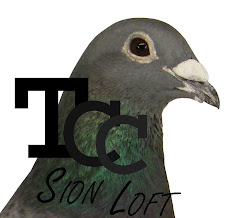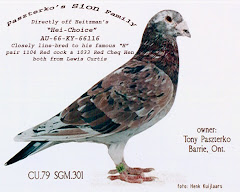The February 1933 issue of "The American Racing Pigeon News" included a 10 page paid advertisement on America's first Hall of Fame Award winner: Mr. Lewis F. Curtis. These pages included praises from leading fanciers of the day, and reprints from international racing pigeon papers.
The following article appeared on May 16th, 1931, in "The Racing Pigeon", published in London, England. The entire page 247, giving illustrations of the birds and their owner as well as the following article, is devoted to the subject.
"World's Record"
America Honors a Remarkable Performance.
Mr. Lewis F. Curtis Receives First Hall of Fame Award
To win the first six prizes in a 600-mile race with six pigeons which dropped into their loft together seems to be an impossible performance, but it has been accomplished by a prominent American Fancier.
This remarkable feat - a world's record - goes to the honor of Mr. Lewis F. Curtis, of Chestnut Hill, Massachusetts, and has earned for him the distinction of being the first fancier to receive the award of the "Hall of Fame". The "Hall of Fame" was originated in 1929 for the purpose of giving due acknowledgment for racing pigeon performances accomplished beyond reasonable expectation and Mr. Curtis, who we enthusiastically compliment, is certainly worthy of being the first to have his name enrolled.
His pigeons, all from Belgian pedigreed stock, accomplished the journey at something like an average speed of 1434 yards per minute.
Perhaps it is best to let the publicity chairman of the American national organizations tell his own story of the birds and the presentation. It is as follows: - On June 28, 1930, a new American record was established by the feat of six racing pigeons belonging to Mr. Lewis F. Curtis, of Chestnut Hill, Massachusetts, returning in 12 hours and 16 minutes together from 600 miles winning the first six positions in the Greater Boston Concourse Association annual 600-mile race, the largest flown in America at this distance with 51 fanciers and 202 birds competing, the birds liberated at Romeo, Michigan, at 5:58 AM and the six winners clocked in at Mr. Curtis's loft at 6:14 PM together, on day of toss. The ancestors of these birds were purchased direct from Messrs. Evrard Havenith, of Antwerp, Belgium, Lucien Bastin, of Verviers, Belgium, Guillaume Stassart, of Anderlecht, Belgium, and Paul Sion, of Tourcoing, France. Mr Theodore Vekens, formerly of Grammant, Belgium, and associated with Mr. Curtis, at his large and palatial lofts called Journey's End, received much praise for his splendid handling of the six winners. Nothing even approaching it had ever before been accomplished and the fanciers who had heretofore been skeptical about the ability of the Belgian racing pigeon were loud in their praise of the four continental fanciers mentioned above who had furnished Mr. Curtis with birds from which he was able to produce such racers.
The following article is taken from editorials on page 223 of the March 27th, 1931, issue of "The Homing Pigeon", published in Birmingham, England.
We have received a copy of the January issue of The American Racing Pigeon News - a particularly fine production printed on art paper and embellished with many illustrations of famous American fanciers, their birds and lofts, and the "Hall of Fame" cover is a composite picture of six racers from the loft of Mr. Lewis F. Curtis, of Chestnut Hill, Massachusetts.
Mr. Curtis' performance in winning the first six positions in the 600-mile race of the Greater Boston Concourse Association of June last gained for him the premier award in the Hall of Fame at the Hotel Pennsylvania, New York City, on January 10th last. It is of interest to note that the strains of birds responsible for this remarkable performance are the Havenith, Stassart, Bastin, and Sion. Judging from the extensive importations of birds made by Mr. Curtis from Belgium, he may be classed as, "The Logan of America".
Praises from leading fanciers of the day:
Verviers, Belguim, August 15, 1932
My dear Mr. Curtis;
I cannot but admire more and more the results that you are securing with the descendants of my pigeons. These are really amazing and I am so pleased that I am really afraid that I shall become altogether too proud thereof.
Cordially and sincerely yours,
Lucien Bastin
Anderlechl, Belgium, September 12, 1932
My dear Mr. Curtis;
Although not personally acquainted with you, I have the highest esteem and the greatest admiration for the Grand National Champion of the United States. Your wonderful exploits during the past three years at 600 miles has also contributed considerably to the growth of your reputation here, which was anyhow very well known and appreciated. Allow me to express the hope that you have only started a long line of triumphs in the fancy.
Very Sincerely,
Guilliame Stassart
Antwerp, Belgium, August 20, 1932
My dear Mr. Curtis;
I am very pleased you are succeeding so splendidly with the birds you imported from our country. Your famous performances with our good birds are most creditable, particularly your performance over three years at 600 miles distance, which has never been approached in the entire racing world. You are certainly the "Premier" of your country and I am happy to acknowledge your strength and knowledge of pigeon racing.
Yours very sincerely,
Evrard Havenith
Tourcoing, France, December 11, 1932
My dear Mr. Curtis,
I am very happy at the successes which you have obtained with the performances of my pigeons. The success gained by you at the 600-mile distance on July 9, 1932, and my success at the 500 miles distance on July 12, 1930, are beyond question the two greatest races ever flown by a single competitor throughout the racing world at these meets. You see that my predictions have been realized and I am very glad about this.
Sincerely Yours,
Paul Sion
Westcombe Park, London, England, August 7, 1932
Dear Mr. Curtis;
Congratulations on the records of your splendid birds. Wonders will never cease.
Best wishes from,
Dr. M. E. Tresidder
Farnworth, England, Austust 11, 1932
My dear Mr. Curtis;
In the forty years I have acted as agent for the Belgians, I have never witnessed such remarkable performances at the long distances as those made by your birds. I never knew anything equal to it in our country. They are World's Records and naturally deserve a recognition equal to it. I note the American Racing Pigeon News takes pride in honoring you while the Editor seems also to be equal to the occasion and "right Well" he has done his work.
Most sincerely yours,
Al Darbyshire
Uccle, Belgium, August 28, 1932
My dear Mr. Curtis;
I wish to thank you from the bottom of my heart for obtaining such fine success at such a long distance during these many years with the pigeons I had sent to you. The Belgian pigeon papers are full of your fame and I am indeed honored and pleased.
Heartily yours,
Alfred Seret
Brussells, Belgium, September 21, 1932
Dear Mr. Curtis;
I have read in our journals the results obtained by your pigeons for the three years past at the distance of 600 miles. I herewith beg to extend my congratulations because this represents a magnificent success.
Yours very truly,
Arthur Lenoir
Schaerbeck, Belgium, October 29, 1932
Dear Mr. Curtis;
Your great wins at 600 miles for the three years past exceeds the brilliant year I enjoyed in 1921 when all my countrymen marvelled at my triumphs. I cannot pay your deserving records greater homage.
Very truly,
Gaston Ryelandt
London, England, August 4, 1932
Dear Mr. Curtis;
Please accept my heartiest congratulations on your splendid performances. I have received several phone messages and letters expressing admiration of your twelve best racers.
Yours faithfully,
W. H. Osman
Sherwood House, Reading, England, October 10, 1932
Dear Mr. Curtis;
My hearty congratulations to you on owning such a team of real champions. I know the difficulties of pigeon racing, therefore my congratulations are very sincere.
Yours faithfully,
W. Fury
Ecaussines, Belgium, September 14, 1932
Dear Mr. Curtis;
Receive my felicitations for the fine successes you have presented, as well as my confraternal salutations.
Very sincerely,
Ernest Duray
Vinderhaute, Belgium, September 7, 1932
Dear Mr. Curtis;
With my best congratulations for your great 600-mile achievements, which are very agreeable to the Belgian fanciers. Also please accept the best wishes of my friends Stassart, Sion, Janssens, and all the other ones of the Belgian National Flying Club.
Yours sincerely,
P. Vanhecke
Verviers, Belgium, October 26, 1932
Dear Mr. Curtis;
I make haste to come and congratulate you upon your brilliant success in the long races. Such achievements in such competition are feats to be proud of and also they go to make our sport the more interesting. I am sure that all true fanciers, even if a bit jealous, will be glad to know of such successes.
Yours most sincerely,
Renier Gurnay
Laeken, Belgium, August 17, 1932
Dear Mr. Curtis;
It is with pleasure that I am cognizant of the great success gained by your pigeons. Your success is not only unique from the far distant points, but most interesting.
Most sincerely,
Albert Warsee

























































